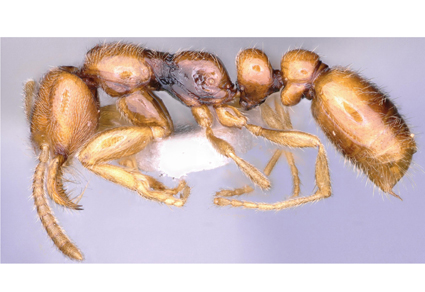Abstract
Leptanillinae, recognized as the most phylogenetically basal ant subfamily of Formicidae, comprises the genus Protanilla—the second most species-rich lineage within this subfamily. Protanilla species exhibit strong ecological specialization, being restricted to pristine primary forests where they inhabit subterranean environments or decayed wood. These ants are characterized by their completely vestigial eyes and extremely cryptic biology, which remains poorly understood. Globally, 20 valid species have been described, with half occurring in China, indicating this region represents the center of diversity for the genus. This study systematically reviewed the Chinese species of the Protanilla Taylor in Bolton, 1990, including two new species: P. xui sp. nov. and P. shanyii sp. nov., and provided an illustrated key to the worker caste of this genus in China.
References
- Baidya, P. & Bagchi, S. (2020) A new species of Protanilla Taylor 1990 (Hymenoptera: Formicidae: Leptanillinae) from India. Halteres, 11, 19–24. https://doi.org/10.5281/zenodo.3941686
- Baroni Urbani, C. & De Andrade, M.L. (2006) A new Protanilla Taylor, 1990 (Hymenoptera: Formicidae: Leptanillinae) from Sri Lanka. Myrmecologische Nachrichten, 8, 45–47.
- Bharti, H. & Akbar, S.A. (2015) First record of genus Protanilla (Hymenoptera: Formicidae: Leptanillinae) from India with description of a new species. Journal of Asia-Pacific Entomology, 18, 573–576. https://doi.org/10.1016/j.aspen.2015.04.008
- Bolton, B. (1990) The higher classification of the ant subfamily Leptanillinae (Hymenoptera: Formicidae). Systematic Entomology, 15, 267–282. https://doi.org/10.1111/j.1365-3113.1990.tb00063.x
- Borowiec, M.L., Rabeling, C., Brady, S.G., Fisher, B.L., Schultz, T.R. & Ward, P.S. (2019) Compositional heterogeneity and outgroup choice influence the internal phylogeny of the ants. Molecular Phylogenetics and Evolution, 134, 111–121. https://doi.org/10.1016/j.ympev.2019.01.024
- Griebenow, Z.H. (2021) Synonymisation of the male-based ant genus Phaulomyrma (Hymenoptera: Formicidae) with Leptanilla based upon Bayesian total-evidence phylogenetic inference. Invertebrate Systematics, 35, 603–636. https://doi.org/10.1071/is20059
- Hsu, P.W., Hsu, F.C., Hsiao, Y. & Lin, C.C. (2017) Taxonomic notes on the genus Protanilla (Hymenoptera: Formicidae: Leptanillinae) from Taiwan. Zootaxa, 4268 (1), 117–130. https://doi.org/10.11646/zootaxa.4268.1.7
- Man, P., Ran, H., Chen, Z.L. & Xu, Z.H. (2017) The northern-most record of Leptanillinae in China with description of Protanilla beijingensis sp. nov. (Hymenoptera: Formicidae). Asian Myrmecology, 9, 12 e009008. https://doi.org/10.20362/am.009008
- Taylor, R.W. (1990) [Untitled. Anomalomyrmini Taylor tribe n., Anomalomyrma Taylor gen. n., Protanilla Taylor gen. n.]. In: Bolton, B. (Ed.), The higher classification of the ant subfamily Leptanillinae (Hymenoptera: Formicidae). Systematic Entomology, 15, pp. 278–279. https://doi.org/10.1111/j.1365-3113.1990.tb00063.x
- Terayama, M. (2009) A synopsis of the family Formicidae of Taiwan (Insecta: Hymenoptera). Research Bulletin of Kanto Gakuen University. Liberal Arts, 17, 81–266.
- Terayama, M. (2013) Additions to knowledge of the ant fauna of Japan (Hymenoptera; Formicidae). Memoirs of the Myrmecological Society of Japan, 3, 1–24.
- Xu, Z.H. (2002) A systematic study on the ant subfamily Leptanillinae of China (Hymenoptera: Formicidae). Acta Entomologica Sinica, 45, 115–120.
- Xu, Z.H. (2012) Furcotanilla, a new genus of the ant subfamily Leptanillinae from China with descriptions of two new species of Protanilla and P. rafflesi Taylor (Hymenoptera: Formicidae). Sociobiology, 59, 477–491. https://doi.org/10.13102/sociobiology.v59i2.612
- Xu, Z.H. & Zhang, J.L. (2002) Two new species of the ant subfamily Leptanillinae from Yunnan, China (Hymenoptera: Formicidae). Acta Zootaxonomica Sinica, 27 (1), 139–144.


